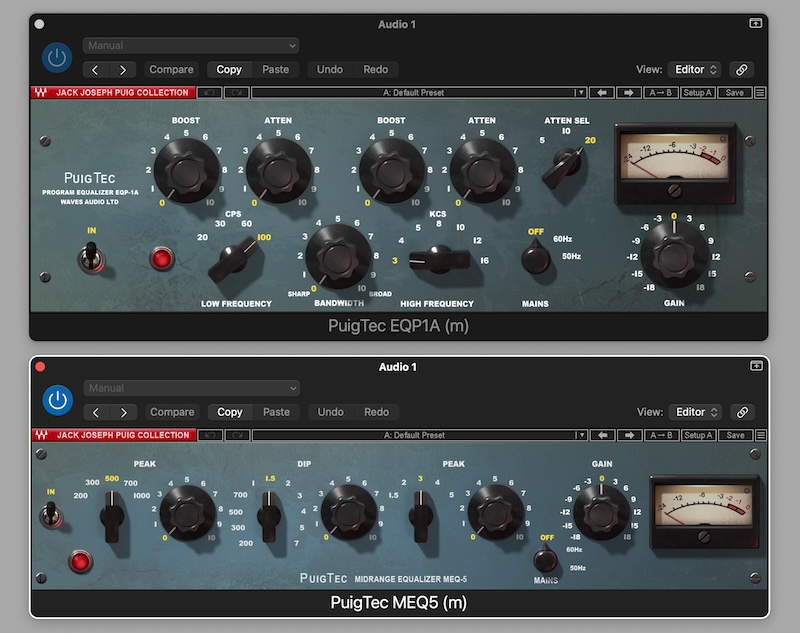-
 play_arrow
play_arrow
Clubalicious Clubalicious Radio
-
 play_arrow
play_arrow
London Calling Podcast Yana Bolder

In the world of DAW recording, digitally modeled plug-ins are everywhere. If so inclined, you can start a project recording through a modeled mic connected to a modeled preamp. You can track your guitars and basses through pedals featuring modeled amps and effects or record them DI and later create their amplified sounds with amp-modeling plug-ins.
You can track your keyboard parts via MIDI and trigger sounds from modeled emulations of classic synths. When you’re done recording, you can mix the project using modeled channel strips from classic analog consoles or individual emulations of compressors, EQs, reverbs, delays, tape machines and even digitally modeled tracking rooms from world-famous studios.
During the mix, you can monitor through plug-ins that model the sound of the high-end monitor systems in specific pro studios; there are even dedicated headphones for that. Finally, you can master using modeled mastering EQs, compressors and more.
It’s been more than 20 years since digitally modeled plug-ins of analog gear were first introduced, with Line 6, Bomb Factory and Roland among the pioneers. Many in the pro audio industry did not take them seriously at first, questioning their sonics and capabilities. However, as developers gained experience over time, that began to change.
A crucial inflection point occurred a little more than 10 years ago as most pro engineers began mixing “in the box,” which motivated them to turn to plug-in versions of LA-2As, 1176s, 1073s, EQP-1As, CL 1Bs and other classic processors, which, in analog form, had long been part of their workflows. The stamp of approval from well-known engineers lent legitimacy to the modeled plug-ins and created more demand.
In the early and mid-2010s, hardwareaccelerated systems, most prominently those from Universal Audio, allowed users to run multiple modeled plug-ins without significantly taxing their computers. With the constant improvement in processing speeds, today’s native computers have enough horsepower to handle numerous, simultaneous modeled plugins, though hardware-accelerated systems—with their lower latency and higher track counts—certainly remain advantageous.

MODELING: WHAT IT IS
In the simplest of terms, digital modeling involves translating the workings and sound of an audio hardware unit, amplifier, room or other physical target into digital data, which is then converted to algorithms and computer code.
When plug-in developers embark on a digital modeling project, they have several options. One is to partner with the manufacturer of the target hardware, which adds authenticity in the eyes of potential customers and provides another crucial benefit: “We try, whenever we can, to work with the hardware manufacturers, to get schematics, inside design information, and sometimes hard-to-find hardware units,” says Will Shanks, who has worked on modeling projects at Universal Audio for 24 years.
Universal Audio, Waves, Softube, Plugin Alliance and others produce quite a few plug-ins in cooperation with manufacturers. UA’s catalog includes the quintessential models of many classic processors, including the 1176 and LA-2A. The company is uniquely positioned with those plugins and others because it’s also the manufacturer.
Another option is to collaborate with an artist, engineer or producer, focusing on one or more of their personal hardware units. Waves is a leader in this area, having joined forces with luminaries such as Chris Lord-Alge, Jack Joseph Puig, Tony Maserati, Greg Wells, Eddie Kramer and Manny Marroquin.
Beabadoobee and Rick Rubin on the Epic Journey from Shangri-La to Number One
Working with the manufacturer is not a prerequisite, however. Many developers do an excellent job modeling a piece of gear without getting the “official” stamp from the hardware maker. An independently made plug-in offers the developer more flexibility to add, subtract or merge features not on the original hardware. This can streamline the user experience or expand the unit’s capabilities. The developer might not always have that leeway in a collaborative project .KIT Plugins is in a unique situation because most of the modeled processors the company has released so far come from Blackbird Studio in Nashville. “Blackbird is our anchor partner,” explains Matt Kleinman, CEO and co-founder of the fast-growing company. “John [McBride, coowner of Blackbird] is a co-owner and co-founder of the business, so the mission from day one was to build plug-ins out of John’s equipment.”
Once a developer has identified a unit to model, the next thing it looks for is one or more pieces of the target hardware that are in good condition. A unit must perform up to spec, which isn’t always the case with older analog hardware.
“There are listening tests and measurements of the units to ensure that they’re functioning properly—running signal through them, doing listening sessions, then taking the hood off to get the unit back to the intended operation like the day it was built. The idea is that you have a near perfect unit to use as a benchmark, as that ‘golden unit,’” says Shanks, noting that UA often takes measurements from more than one unit in a modeling project because the performance of analog hardware can vary from one to the next. “The goal is getting our plug-ins within a spread. We still use one unit as the benchmark, but ideally, our reference unit falls right in the nominal zone of unit-to-unit variation.”
Getting a schematic that shows how the device works internally is critical. The developer can then decide which modeling technique to apply only by looking at the schematic and testing the unit.

METHODS OF MODELING
“Signal modeling” is one way to go. It’s based on measurements from the input and output using a variety of input levels, sources and knob settings. It doesn’t try to re-create the internal components, which is why it’s also called “black-box modeling.” The more knobs and switches on the hardware, the more variables that need measurement.
“A good example of where that is problematic controls,” says Arvid Rosén, Vice President of Research and Development at Softube, a company with nearly two decades of modeling experience. “If you have 20 knobs, the number of control combinations [to measure] is just astronomical.”
“It’s a useful technique and has its place,” says Shanks of signal modeling. “We have used it ourselves when it makes sense, but its limitations are that it cannot fully and accurately represent a complex system with multiple and interdependent nonlinearities.”
Shanks is referring to the fact that an analog signal gets saturated when overdriven, and the complexities of where the points of saturation come from are a critical part of what makes analog audio sound the way it does. Whether it’s the distortion of the tubes in a guitar amp interacting with a transformer or the way the bands of an EQ may be interdependent, the plug-in version should be able to replicate it.
“Circuit modeling,” sometimes called “whitebox modeling,” has proven the most accurate way to reproduce an analog device digitally. It involves creating a mathematical model of the circuit and each component in the hardware’s signal path and then digitally reassembling the elements to match the original design.

“Almost everything UA does related to emulations is circuit modeling,” says Shanks. As an example, he compares UA’s original UAD-1 1176 plug-in, one of the company’s first modeling projects, to its more recent UAD-2 emulation. “When we did the first version, it focused on the most important part of the 1176, which naturally is the compression circuit—the compression detection and its time constants, and this is a ‘focused’ circuit model. Then around 2012 or 2013, we expanded that to be what we call an ‘end-to-end’ circuit model that also takes into account the transformers and amplifiers, the nonlinearities of hitting the input and everything else.”
Hybrid projects that feature a combination of techniques are also common. “My goal for KIT Plugins is to build what we call real-world models,” Kleinman says. “‘How do I get the same feel, sound and creative effect that the piece of gear has in the studio in a plug-in?’ So, for some of our plug-ins, particularly our channel strips, we lean more on algorithms tuned to match the output [black-box modeling]. The more complicated the gear, the more we’ve leaned into component modeling.”
Some developers have started integrating AI into the modeling process. One of the leading companies in this area is Neural DSP, which uses neural networks—an AI technology that allows a computer to predict what will happen at an output based on changes at the input—to create blackbox models of guitar amplifiers. To overcome the challenge of capturing data from an exorbitant number of control combinations, Neural DSP built a proprietary data collection robot called TINA (Telemetric Inductive Nodal Actuator).
The company describes how it works: “TINA figures out what control positions need to be recorded, plans the schedule to turn the knobs while minimizing wear-and-tear, and finally returns to you with a collection of recordings annotated with the related control positions.”
Kleinman says that KIT is also integrating AI engines into plug-in development: “I think using AI in the way we do, to replace DSP, is a big part of the future.”
COME BACK TOMORROW FOR THE CONCLUSION!
Written by: Admin
Similar posts
Recent Posts
- 🎶 New Music: JID, OneRepublic, Morgan Wallen, Post Malone, MarkCutz, Kidd Spin + More!
- Classic Tracks: The Fireballs’ “Sugar Shack”
- Classic Tracks: Arlo Guthrie’s “City of New Orleans”
- Classic Track: k.d. lang’s “Constant Craving”
- Classic Tracks: Waylon Jennings’ “Are You Sure Hank Done It This Way”
Recent Comments
No comments to show.Featured post

Latest posts

🎶 New Music: JID, OneRepublic, Morgan Wallen, Post Malone, MarkCutz, Kidd Spin + More!

Classic Tracks: The Fireballs’ “Sugar Shack”

Classic Tracks: Arlo Guthrie’s “City of New Orleans”

Classic Track: k.d. lang’s “Constant Craving”

Classic Tracks: Waylon Jennings’ “Are You Sure Hank Done It This Way”
Current show
Upcoming shows

Femme House
Lp giobbi
19:00 - 20:00
Stereo Productions
Chus Ceballos
20:00 - 21:00
Fresh Is Fresh
This Weeks Hottest Releases
21:00 - 00:00
Love To Be
The Global Connection
00:00 - 02:00
Fresh Is Fresh
This Weeks Hottest Releases
02:00 - 09:00Chart
Powered by Dee jay promotions visit us








 Invalid license, for more info click here
Invalid license, for more info click here